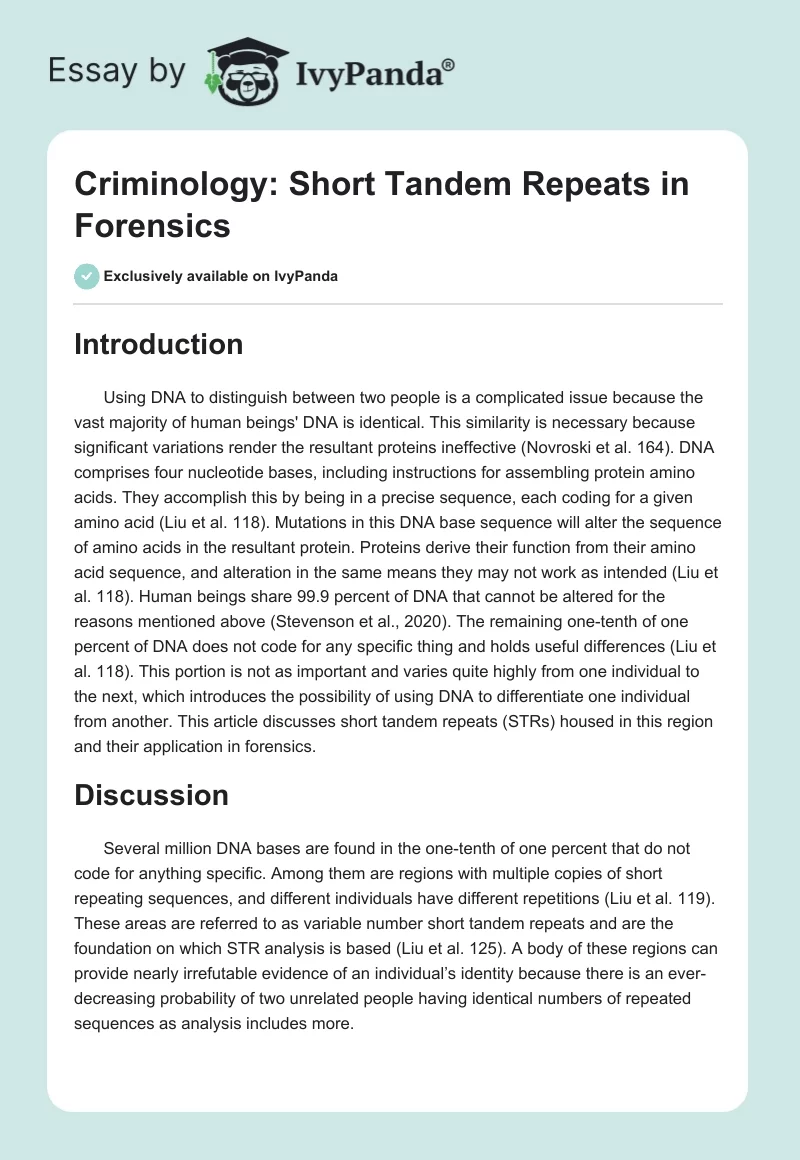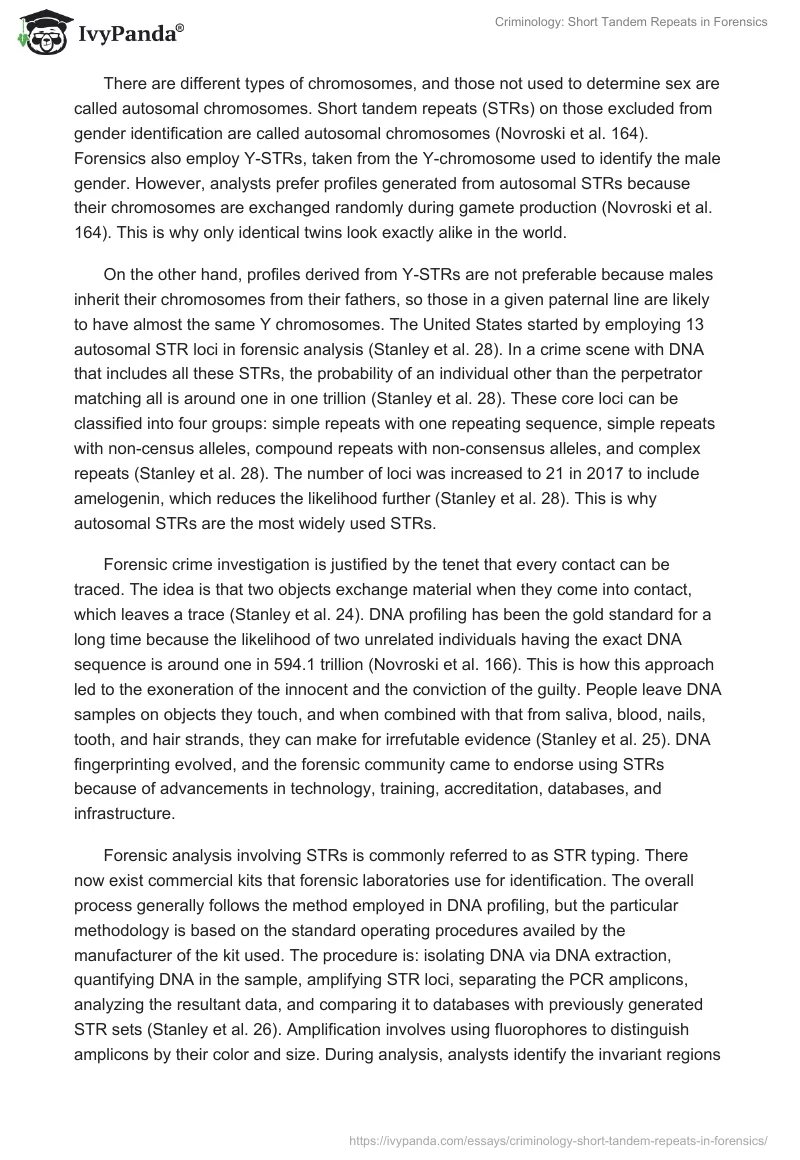Introduction
Using DNA to distinguish between two people is a complicated issue because the vast majority of human beings’ DNA is identical. This similarity is necessary because significant variations render the resultant proteins ineffective (Novroski et al. 164). DNA comprises four nucleotide bases, including instructions for assembling protein amino acids. They accomplish this by being in a precise sequence, each coding for a given amino acid (Liu et al. 118). Mutations in this DNA base sequence will alter the sequence of amino acids in the resultant protein. Proteins derive their function from their amino acid sequence, and alteration in the same means they may not work as intended (Liu et al. 118). Human beings share 99.9 percent of DNA that cannot be altered for the reasons mentioned above (Stevenson et al., 2020). The remaining one-tenth of one percent of DNA does not code for any specific thing and holds useful differences (Liu et al. 118). This portion is not as important and varies quite highly from one individual to the next, which introduces the possibility of using DNA to differentiate one individual from another. This article discusses short tandem repeats (STRs) housed in this region and their application in forensics.
Discussion
Several million DNA bases are found in the one-tenth of one percent that do not code for anything specific. Among them are regions with multiple copies of short repeating sequences, and different individuals have different repetitions (Liu et al. 119). These areas are referred to as variable number short tandem repeats and are the foundation on which STR analysis is based (Liu et al. 125). A body of these regions can provide nearly irrefutable evidence of an individual’s identity because there is an ever-decreasing probability of two unrelated people having identical numbers of repeated sequences as analysis includes more.
There are different types of chromosomes, and those not used to determine sex are called autosomal chromosomes. Short tandem repeats (STRs) on those excluded from gender identification are called autosomal chromosomes (Novroski et al. 164). Forensics also employ Y-STRs, taken from the Y-chromosome used to identify the male gender. However, analysts prefer profiles generated from autosomal STRs because their chromosomes are exchanged randomly during gamete production (Novroski et al. 164). This is why only identical twins look exactly alike in the world.
On the other hand, profiles derived from Y-STRs are not preferable because males inherit their chromosomes from their fathers, so those in a given paternal line are likely to have almost the same Y chromosomes. The United States started by employing 13 autosomal STR loci in forensic analysis (Stanley et al. 28). In a crime scene with DNA that includes all these STRs, the probability of an individual other than the perpetrator matching all is around one in one trillion (Stanley et al. 28). These core loci can be classified into four groups: simple repeats with one repeating sequence, simple repeats with non-census alleles, compound repeats with non-consensus alleles, and complex repeats (Stanley et al. 28). The number of loci was increased to 21 in 2017 to include amelogenin, which reduces the likelihood further (Stanley et al. 28). This is why autosomal STRs are the most widely used STRs.
Forensic crime investigation is justified by the tenet that every contact can be traced. The idea is that two objects exchange material when they come into contact, which leaves a trace (Stanley et al. 24). DNA profiling has been the gold standard for a long time because the likelihood of two unrelated individuals having the exact DNA sequence is around one in 594.1 trillion (Novroski et al. 166). This is how this approach led to the exoneration of the innocent and the conviction of the guilty. People leave DNA samples on objects they touch, and when combined with that from saliva, blood, nails, tooth, and hair strands, they can make for irrefutable evidence (Stanley et al. 25). DNA fingerprinting evolved, and the forensic community came to endorse using STRs because of advancements in technology, training, accreditation, databases, and infrastructure.
Forensic analysis involving STRs is commonly referred to as STR typing. There now exist commercial kits that forensic laboratories use for identification. The overall process generally follows the method employed in DNA profiling, but the particular methodology is based on the standard operating procedures availed by the manufacturer of the kit used. The procedure is: isolating DNA via DNA extraction, quantifying DNA in the sample, amplifying STR loci, separating the PCR amplicons, analyzing the resultant data, and comparing it to databases with previously generated STR sets (Stanley et al. 26). Amplification involves using fluorophores to distinguish amplicons by their color and size. During analysis, analysts identify the invariant regions bounding the repeats, upon which they can designate PCR primers and amplify the repeat region for analysis (Stanley et al. 26). This is how STRs are identified for further comparison and analysis.
As discussed above, STRs are associated with a high degree of polymorphism, and loci are differentiated by the number of repeat sequences within each. The more loci used in typing, the greater the accuracy of the process because there is an extremely small likelihood of two randomly selected individuals having an identical number of repeats (Liu et al. 123). After generating STR sequences from crime scene DNA, forensic analysts can compare them to those from a list of suspects or DNA databases.
Amplification technology in STR analysis facilitated the creation of effective and efficient DNA databases. One of the most prominent advancements in forensics was the creation of criminal DNA databases. These containers hold personal DNA profiles and results derived from crime scenes, with the primary function of producing hits between STR sequences from DNA found in crime scenes and stored profiles of victims, convicted offenders, and suspects (Novroski et al. 165). The following facts justify the development and expansion of DNA databases:
- Very often, a few criminals are often perpetrators of numerous crimes. These databases will help in linking the crimes to each other.
- Crime severity often increases over time when it is committed by repeat offenders.
- Criminals have a tendency to re-offend or commit crimes repeatedly.
Criminal investigations have evolved with the increased necessity of increasing efficiency and effectiveness. Traditional identification based on physical and anthropological characteristics quickly became obsolete as perpetrators resorted to sophisticated means of committing crimes. One of the most significant developments was the use of DNA profiling to process crime scenes. This method’s reliability and admissibility lie in the fact that no two individuals are likely to have identical DNA sequences. Technological advancements and medical discoveries introduced refinements that led to the unanimous adoption of STR typing. This approach uses short tandem repeats, short DNA sequences repeated numerous times, to reduce the probability of a DNA sample belonging to two randomly selected individuals.
Conclusion
Now the gold standard in forensics, STR sequencing has led to the conviction of perpetrators and exonerated innocent people. The creation of national DNA databases went a long way in smoothening the methodology because often criminals are likely to re-offend, a small number commit multiple crimes, and the severity of the crime increases over time when perpetrated by repeat offenders.
Works Cited
Liu, Yao-Yuan, and SallyAnn Harbison. “A Review of Bioinformatic Methods for Forensic DNA Analyses.” Forensic Science International: Genetics, vol. 33, 2018, pp. 117-128, Web.
Novroski, Nicole MM, August E. Woerner, and Bruce Budowle. “Potential Highly Polymorphic Short Tandem Repeat Markers for Enhanced Forensic Identity Testing.” Forensic Science International: Genetics, vol. 37, 2018, pp. 162-171, Web.
Stanley, Udogadi Nwawuba, et al. “Forensic DNA Profiling: Autosomal Short Tandem Repeat as A Prominent Marker in Crime Investigation.” The Malaysian Journal of Medical Sciences: MJMS, vol. 27, no. 4, 2020, pp. 22-35, Web.


